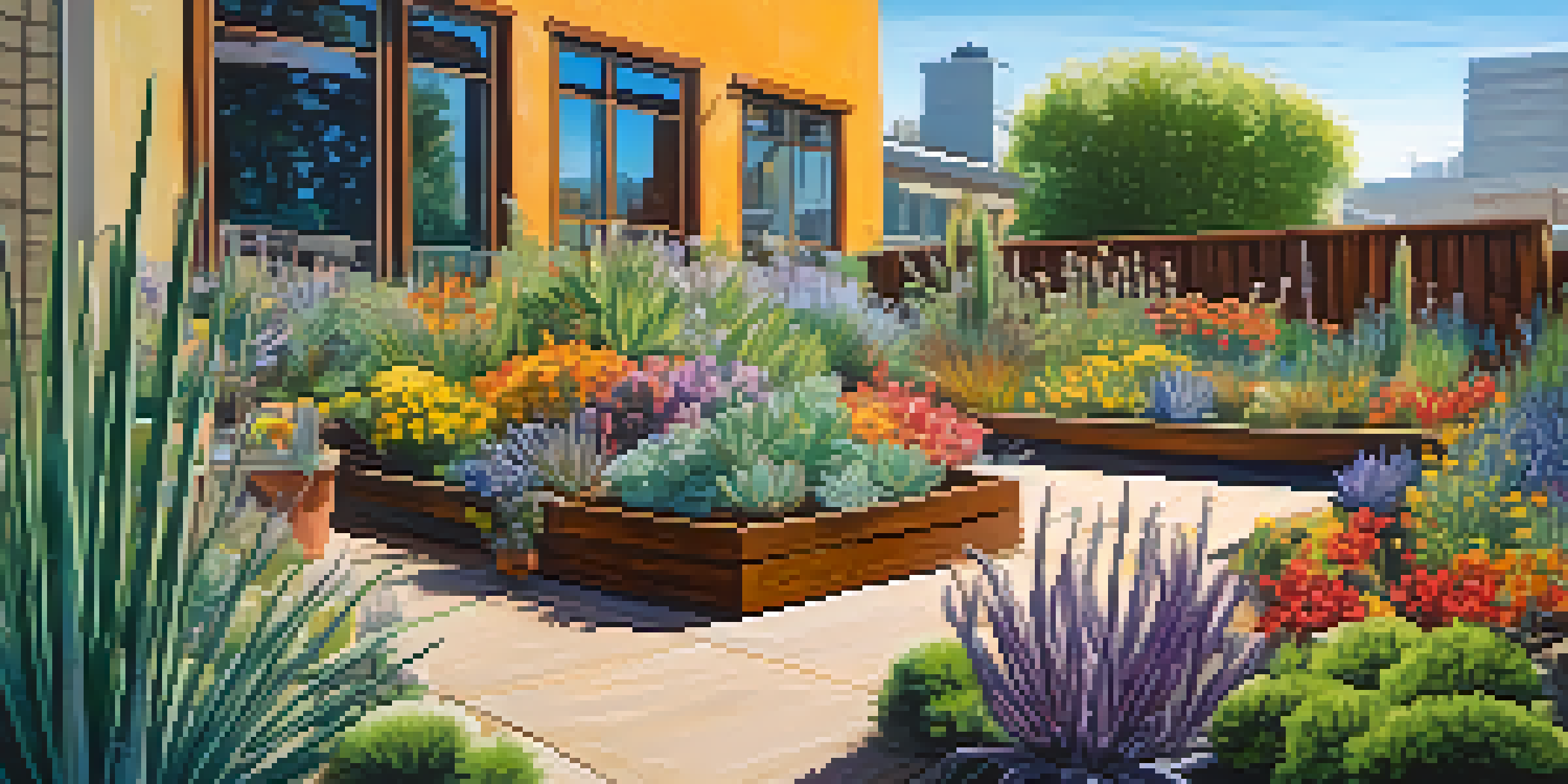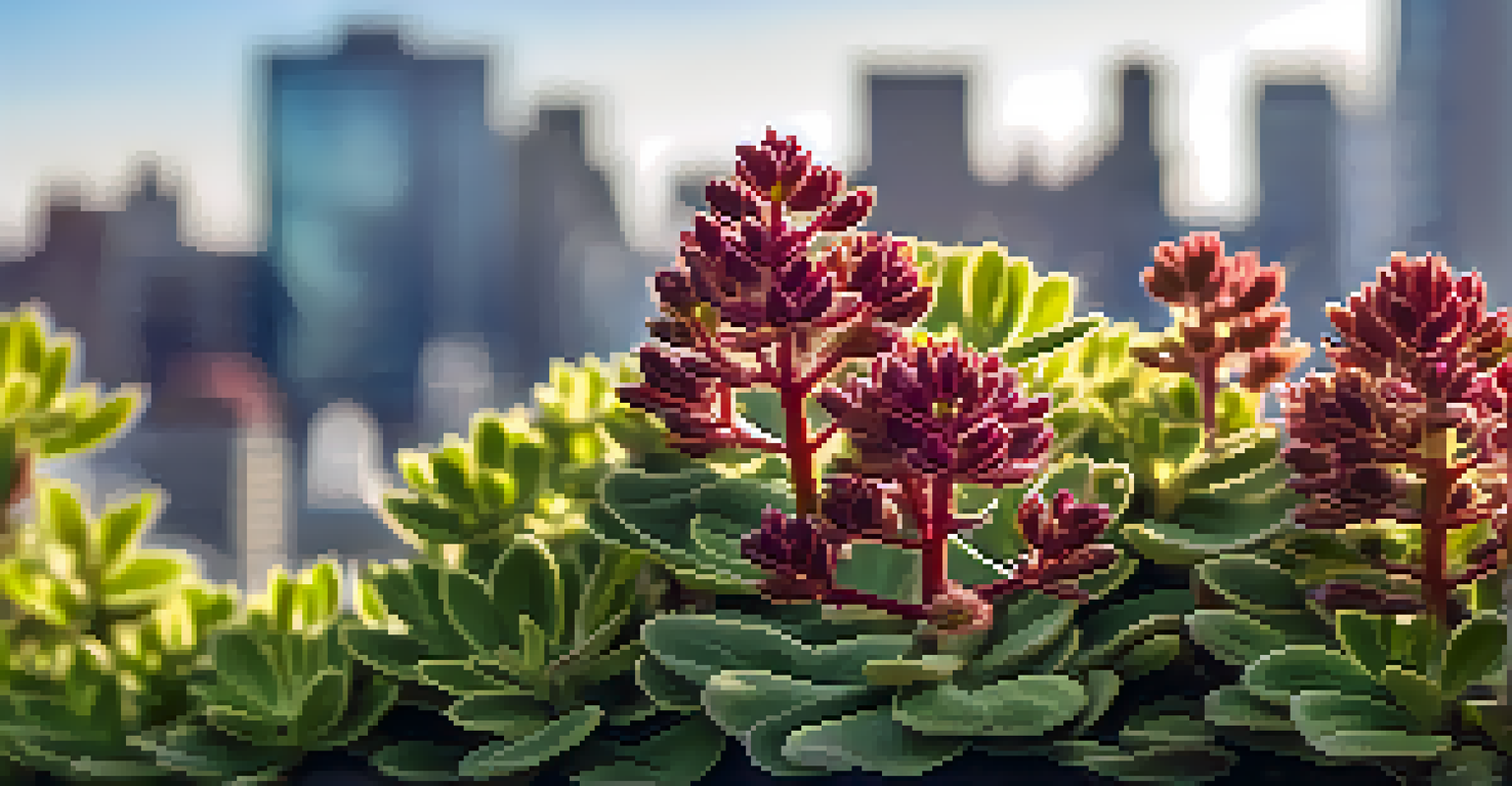Cultivating Heat-Tolerant Plants for Urban Environments

Understanding Heat-Tolerant Plants for City Gardens
Heat-tolerant plants are specially adapted to thrive in high temperatures, making them perfect for urban gardens. These plants can withstand the stresses of heat, drought, and pollution, which are common in cityscapes. By choosing the right varieties, urban gardeners can create lush, vibrant spaces that not only beautify their surroundings but also contribute to biodiversity.
The greatest threat to our planet is the belief that someone else will save it.
In essence, heat-tolerant plants help offset the urban heat island effect, where cities become significantly warmer than their rural counterparts. This not only aids in creating cooler microclimates but also supports local wildlife by providing essential habitats. Understanding these plants is the first step toward a sustainable urban gardening experience.
Examples of heat-tolerant plants include succulents, lavender, and certain types of ornamental grasses. These species are resilient and require less water, making them ideal for busy city dwellers who may not have time for extensive garden maintenance. Embracing these plants can lead to a thriving garden, even in the harshest conditions.
Choosing the Right Plants for Your Urban Garden
Selecting the right heat-tolerant plants begins with understanding your local climate and soil conditions. Researching native species is a great start, as they are naturally suited to your environment and require less care. Additionally, consider factors like sunlight exposure and water availability when making your choices.

For instance, if you live in a particularly sun-drenched area, you might opt for plants like sedums or agaves that can handle intense heat. Meanwhile, shade-loving options such as hostas may not be suitable for these conditions. Choosing the right plants not only enhances the beauty of your garden but also ensures that they thrive with minimal intervention.
Choose Plants for Urban Conditions
Selecting heat-tolerant plants that suit your local climate and soil ensures a thriving urban garden.
Don’t forget to visit local nurseries or garden centers, as they often have expert advice and a selection of plants that are well-suited to your area. Engaging with local gardeners can also provide insights into what works best in your specific urban setting, making your gardening journey more rewarding.
Creating a Suitable Garden Environment for Heat-Tolerant Plants
Creating a suitable environment for your heat-tolerant plants involves proper planning and care. Start by assessing your garden's layout; ensure that plants are positioned according to their sun and shade needs. Grouping plants with similar requirements can help maintain optimal microclimates.
Gardening adds years to your life and life to your years.
Soil quality is another vital consideration. Incorporating organic matter, like compost, can enhance soil structure and moisture retention, providing your plants with the nutrients they need. Well-drained soil is essential to prevent root rot, especially during hot, dry spells.
Additionally, consider implementing mulch around your plants. This practice helps regulate soil temperature, retain moisture, and suppress weeds, which can compete for resources. A well-maintained garden environment sets the stage for your heat-tolerant plants to flourish.
Watering Techniques for Heat-Tolerant Plants
Watering is a crucial aspect of cultivating heat-tolerant plants, especially during dry periods. Deep watering less frequently is often more beneficial than shallow, frequent watering. This encourages deeper root growth, which helps plants access moisture from lower soil layers during hot weather.
Using drip irrigation systems or soaker hoses can provide efficient, targeted watering without waste. This technique not only conserves water but also minimizes the risk of fungal diseases by keeping foliage dry. Plus, it allows you to maintain consistent moisture levels, which is vital for plant health.
Create Optimal Garden Environments
Proper planning, including soil quality and plant placement, is crucial for the success of heat-tolerant plants.
Monitoring your plants for signs of stress, such as wilting or yellowing leaves, can guide your watering schedule. Keep in mind that while these plants are heat-tolerant, they still require water to thrive. Adjusting your approach based on weather conditions will ensure your garden remains vibrant and healthy.
Mulching: A Key to Moisture Retention and Temperature Control
Mulching is an essential practice for maintaining moisture and regulating soil temperature in urban gardens. By applying a layer of organic or inorganic material around your plants, you create a barrier that protects the soil from extreme temperatures. This not only helps retain moisture but also improves soil health over time as organic mulches break down.
Moreover, mulching suppresses weed growth, which can compete with your plants for water and nutrients. A well-mulched garden is easier to maintain and provides a more aesthetically pleasing appearance. Using materials like wood chips, straw, or bark can add texture and color to your garden design.
Remember to replenish mulch as it decomposes or is washed away. A consistent layer of mulch can make a significant difference in how well your heat-tolerant plants perform, especially during the hottest months of the year. This simple technique can transform your garden into a thriving oasis.
Companion Planting for Enhanced Growth and Resilience
Companion planting is a technique that involves grouping plants together for mutual benefits, and it can be particularly effective in urban gardens. By strategically selecting companion plants, you can improve growth, deter pests, and enhance the overall resilience of your garden. This method creates a more balanced ecosystem that can better withstand heat and drought.
For example, planting marigolds alongside vegetables can help repel certain insects, while herbs like basil can improve the growth of tomatoes. The key is to choose plants that complement each other’s needs and characteristics. This not only makes your garden more productive but also adds layers of color and texture.
Practice Effective Watering Techniques
Deep watering less frequently and using efficient irrigation methods helps maintain healthy plants during dry spells.
In urban environments, where space can be limited, companion planting maximizes your garden’s potential. It encourages biodiversity and can lead to healthier plants that are better equipped to handle the stress of heat. Experimenting with different pairings can reveal surprising benefits and enhance your gardening experience.
Maintaining Your Urban Garden Year-Round
Maintaining your urban garden throughout the year is crucial for the success of heat-tolerant plants. Seasonal changes bring different challenges, and being proactive can make a significant difference. Regularly checking your plants for pests, diseases, or nutrient deficiencies is essential to keep them thriving.
Additionally, seasonal pruning and deadheading can encourage new growth and prolong blooming periods. It’s also beneficial to adjust your watering and mulching strategies as the weather changes, ensuring plants have access to what they need when they need it most. Keeping a garden journal can help you track your observations and adjustments over time.

Lastly, engaging with your local gardening community can provide valuable insights and support. Sharing experiences and tips with fellow urban gardeners can enhance your knowledge and inspire creative solutions to common challenges. A well-maintained garden is not just a joy to behold; it’s a testament to your dedication and love for nature.